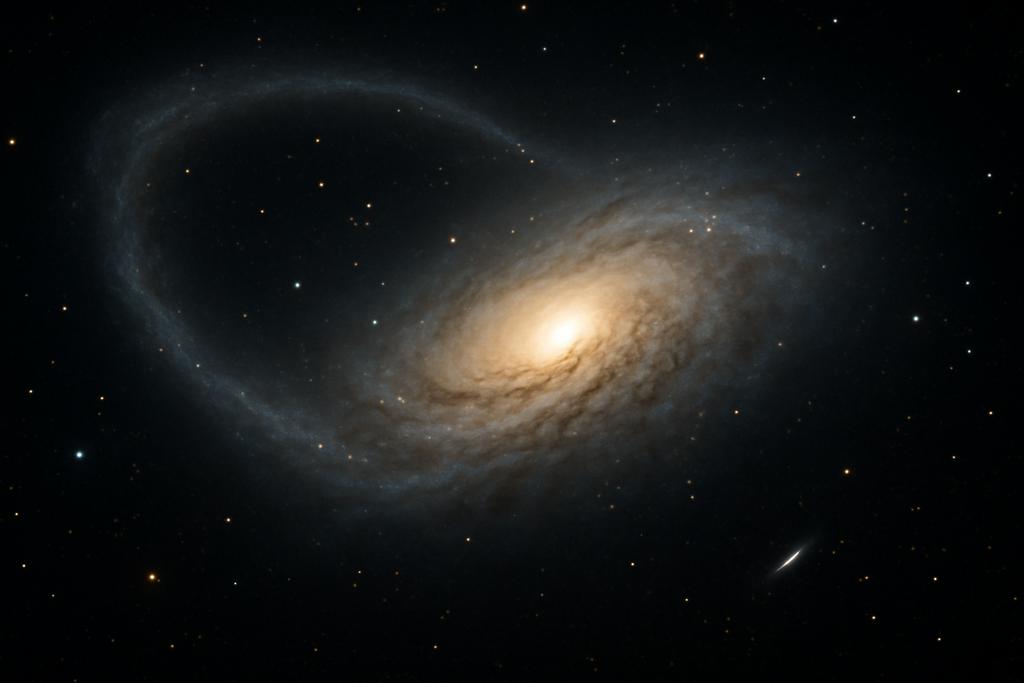Tracing the Invisible with Cosmic Tidal Streams
Galaxies are not isolated islands but dynamic cities shaped by cosmic collisions and mergers. When a small galaxy ventures too close to a larger one, gravity tears it apart, leaving behind delicate stellar streams—ghostly rivers of stars arcing through space. These streams are more than just beautiful remnants; they are cosmic signposts, tracing the invisible scaffolding of dark matter that envelops galaxies.
Elisabeth Sola and colleagues at the University of Cambridge, along with collaborators from institutions including EPFL and Princeton, have embarked on an ambitious project to map these faint stellar streams around nearly 20,000 nearby galaxies. Their work, published in Monthly Notices of the Royal Astronomical Society, introduces STRRINGS, a carefully curated sample of 35 long, narrow streams ideal for probing the dark matter halos that govern galaxy evolution.
Why Streams Matter More Than Meets the Eye
Dark matter remains one of the universe’s greatest mysteries. It neither emits nor absorbs light, making it invisible to telescopes. Yet, it dominates the mass of galaxies and their surroundings, shaping their formation and fate. Stellar streams, formed when smaller galaxies are gravitationally shredded, act like cosmic breadcrumbs. Their shapes and motions are sculpted by the gravitational potential of the host galaxy’s dark matter halo.
By studying these streams, astronomers can infer the distribution and shape of dark matter halos—information crucial to testing cosmological models and understanding galaxy assembly. Until now, detailed stream studies have been largely confined to our Milky Way and its neighbors, where individual stars can be resolved. Extending this to thousands of galaxies requires innovative techniques to detect streams as faint, diffuse light.
Peeling Back the Layers with Residual Imaging
The team leveraged data from the Dark Energy Spectroscopic Instrument Legacy Imaging Surveys (DESI-LS), which provides deep, wide-field images in multiple optical bands. But the real breakthrough came from using residual images: by modeling and subtracting all known sources of light in a galaxy image, the leftover residuals highlight faint asymmetries—like tidal streams—that are otherwise lost in the glare.
Visual inspection of these residuals, combined with the original and model images, allowed the researchers to identify tidal features with unprecedented clarity. They classified features into streams, tails, shells, plumes, and disturbed halos, carefully distinguishing between them based on morphology and brightness.
A Census of Cosmic Scars
Among the 19,387 galaxies studied (all within about 85 million light-years), about 12% showed signs of tidal features. Streams were found around 4.4% of galaxies, with a higher incidence in massive and early-type galaxies. The fraction of galaxies with tidal features rose sharply with stellar mass—from just a few percent in small galaxies to over a third in the most massive ones.
Interestingly, galaxies in groups exhibited tidal features three times more often than isolated galaxies, reflecting the increased likelihood of interactions in crowded environments. This census aligns broadly with theoretical expectations from hierarchical galaxy formation, where galaxies grow by cannibalizing smaller companions.
STRRINGS: The Gold Standard for Stream Studies
From their catalog, the team selected 35 streams that are long, curved, and faint enough to serve as clean tracers of minor mergers—ideal for modeling the underlying dark matter potential. These streams have median lengths around 124,000 light-years and widths of about 18,000 light-years, often stretching far beyond their host galaxies’ visible edges.
The streams’ surface brightness hovers near the detection limits of current surveys, underscoring the challenge of finding these ephemeral structures. Their stellar masses, typically a few hundred million times that of the Sun, correspond to minor mergers with mass ratios between 1:100 and 1:10 relative to their hosts.
Moreover, the team identified six candidate dwarf galaxies embedded within some streams, likely the remnants of the disrupted progenitors. These progenitors tend to be bluer and less massive than their hosts, consistent with expectations for satellite galaxies undergoing tidal stripping.
Implications and the Road Ahead
STRRINGS represents a crucial step toward using stellar streams as a statistical tool to map dark matter halos across the nearby universe. By modeling the geometry and brightness of these streams, astronomers can constrain the shape and mass distribution of dark matter, testing predictions of cosmological simulations.
The study also highlights the power of residual imaging combined with human expertise, setting the stage for future automated searches using machine learning. Upcoming surveys like the Rubin Observatory’s LSST and the Euclid mission will dramatically expand the number of detectable streams, enabling population-level studies of galaxy assembly and dark matter structure.
As Sola and colleagues note, these ghostly streams are not just relics of galactic violence—they are delicate tracers of the unseen cosmic web, whispering secrets about the dark matter halos that cradle galaxies. By listening carefully, we edge closer to unraveling the universe’s hidden architecture.










